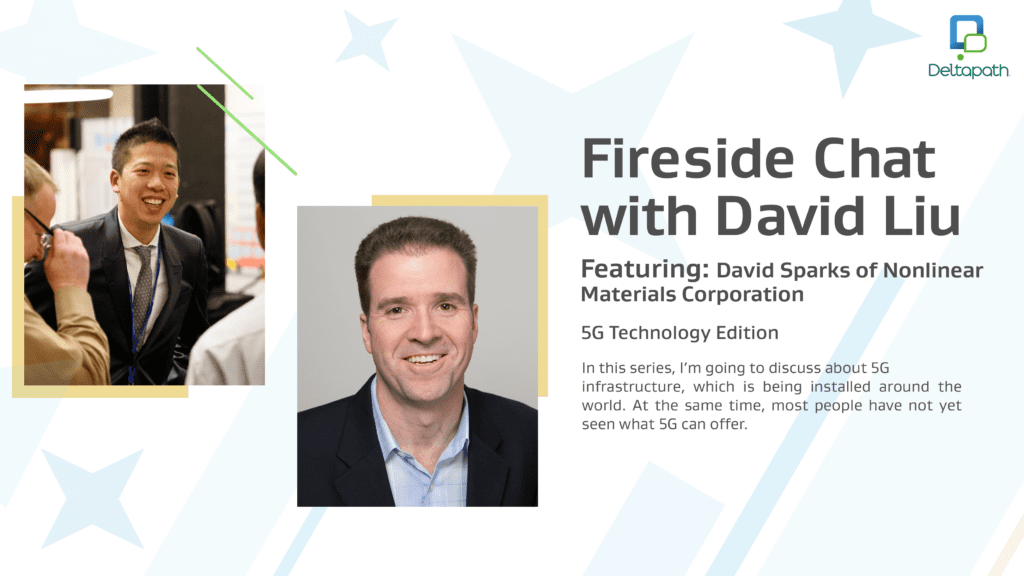
5G infrastructure is being installed around the world. At the same time, most people have not yet seen what 5G can offer. What exactly is 5G? How will it improve our lives? What are the concerns that need to be addressed before it is widely adopted?
In our series, called, How 5G Technology May Improve and Impact Our Lives, we are talking to tech and telecom leaders who can share how 5G can impact and enhance our lives.
As a part of this series, I had the pleasure of interviewing David Sparks.
As the founder and CEO of three consecutive successful startup entities from inception to exit and integration, David Sparks has led technology startups focused on wireless network development over the past 25 years. Currently, he is president of AscentWireless Consulting, an advisory board member at Nonlinear Materials Corporation, and an elected commissioner for a King County Utility District in Washington state. He led the national installation and integration of AT&T’s initial last mile solution with Project Angel as president of Davis Bay, scaling and optimizing wireless carrier rollouts.
Thank you so much for joining us in this interview series! Before we dive in, our readers would love to “get to know you” a bit better. Can you tell us a bit about your ‘backstory’ and how you got started?
I began in wireless after an early startup experience during grad school in the mid-1990s. That led me to a role at a leading wireless network development company, which focused on cellular tower development. While this startup failed, the relationships I built opened critical doors with an investing company and formed the basis of my shift into emerging wireless networks. My focus has remained on leveraging emerging technological trends to increase the efficiency of operations and reduce the time and cost of deploying new technologies.
Can you share the most interesting story that happened to you since you began your career?
Building and installing wireless networks on high towers at altitude certainly means risk. Thankfully, no one has ever suffered any significant injury. Our crew worked 100 feet up during one such venture, replacing a leg on a 250-foot tower. Suddenly, a gust of wind tipped the tower over, with our crew lead attached to the falling piece. He managed to unclip himself and miraculously bounced off a lower microwave dish. He left a large dent in the microwave dish and was shaken up but unhurt after his 100-foot fall!
Can you please give us your favorite “Life Lesson Quote”? Can you share how that was relevant to you in your life?
My go-to life lesson continues to be “luck favors the well prepared.” It’s impossible to know what the future holds, but a continued effort on even low-probability outcomes expands the range of positive outcomes you are prepared to capitalize on. Combine that with a first-principles approach to analyzing challenges, and you have a good chance of solving emerging challenges in a novel and often competitively advantageous manner.
None of us are able to achieve success without some help along the way. Is there a particular person who you are grateful towards who helped get you to where you are? Can you share a story about that?
Mentors and supporters are critical to anyone’s long-term success. Understanding how to develop, nurture, and protect developmental relationships is a core skill and capability. One of my most crucial supporters grew out of an early startup failure where I stayed true to my values despite the near-term economic cost. Learning that a startup’s failure is not synonymous with personal failure was an early key lesson for me. Your focus should be on delivering your best contributions while staying true to your long-term goals around how you are as a contributor or leader. Never lose sight of how that contributes to the career long narrative you are crafting.
You are a successful business leader. Which three character traits do you think were most instrumental to your success? Can you please share a story or example for each?
The first is honesty. If people know they can rely on what you commit to, you can develop the exceptional teams necessary to achieve exceptional outcomes.
The second is persistence; while you occasionally get a home run on the first pitch, most success is built on a daily incremental effort to improve fundamental skills and processes. Honesty and persistence often combine in business when early “momentum” leaders who are not focused on core processes falter; those who have continued to build the teams and processes for long-term success can deliver success for their clients.
Lastly, a generous nature that shares the credit for success back into the team that drove the success. While this may dim the immediate spotlight, sharing credit lays the groundwork for future successes by rewarding those who did the work and made the sacrifices.
Are you working on any new or exciting projects? How do you think that will help people?
Speed — or bandwidth — is the defining characteristic of 5G (and 6, 7, or 8G networks to come), and my most exciting current project at Nonlinear Materials Corporation (NLM) tackles this. NLM’s technology delivers terahertz speeds in a nanoscale photonic component, and the speed is unmatched.
In addition to being the smallest and fastest solutions, photonic components are also incredibly energy efficient, reducing direct electrical consumption and, for 100,000+ scale deployed networks, the costs of systems to dissipate the heat that higher energy-usage silicon components generate. It’s fun and exciting to watch firsthand as the future of computational and antenna components are developed. Not only are we unlocking potential, but we are building foundation-ally better and more eco-friendly devices as demand soars beyond most of our imaginations.
Ok wonderful. Let’s now shift to the main focus of our interview. Like 4G, 5G has many different facets, and I’m sure many will approach this question differently. But for the benefit of our readers can you explain to us what 5G is? How is 5G different from its predecessor 4G?
5G is the extension of 20 years of progression as data capacity has steadily grown. Shorthand for fifth-generation wireless standards, 5G focuses on orders of magnitude growth in bandwidth and data capacity. The shift from smart networks to smart devices has dramatically increased the flexibility of networks while also requiring greatly increased bandwidth from those networks.
When fully deployed, 5G will deliver 10 gigabits per second in capacity and enable ubiquitous, always-on access to the network and the cloud.
This moves us closer to the “Negroponte Switch” where services that used to be connected with dedicated hardline connections between data centers are fully migrated to online wireless last miles and available to everyone on the network 24/7.
5G bandwidth will enable very low-latency, high-definition solutions to be deployed in most major metropolitan areas in the coming years. In addition, operating behind the scenes will be an always-on IoT network enabling interconnectivity between a new generation of smart devices throughout our daily lives. This will mean an open door for evolving services to capitalize on this new bandwidth wealth.
Can you share three or four ways that 5G might improve our lives? If you can please share an example, for each.
As connectivity improves, it enables people to engage with a rapidly expanding ecosystem of “expert systems” that help us find and leverage the highest quality and most advanced knowledge across a global range of topics. As the cumulative knowledge continues to double at an increasing rate, it enables vastly improved decision-making on a global scale. This enables a second improvement, as most of the world is tapped into an almost instantaneous “best practices” feedback loop where novel ideas and inventions are disseminated to all points within the network almost instantaneously. Lastly, to digest and curate that level of information, new high-capacity editorial capabilities (AI, machine learning, and more) are in development that hope to better leverage information development and deliver good, reliable information to the end user on a scale never before imagined.
Keeping “Black Mirror” in mind, can you see any potential drawbacks about this 5G technology that people should think more deeply about?
A good “Black Mirror” example naturally falls out if we cannot improve the editorial filtering of the vast wave of newly available data and transform it into usable information. We’ve already seen the effects of misinformation spreading on social networks or even businesses struggling to access the correct information in their own systems to make wise decisions. Filtering the current cacophony of data and enabling humanity to leverage the most applicable and accurate information in unique, decision-focused environments is the challenge of the coming years.
This is where our (NLM’s) ability to deliver exponentially smaller, faster, and more energy-efficient components holds the key to making future networks robust enough to process the wave of data into useful and incredibly powerful information. As a big personal fan of Churchill, “if you are going through hell, keep going” seems applicable for the current data and information challenges we face. Better systems will eventually provide more advantages with fewer drawbacks.
Some have raised the question that 5G might widen the digital divide and leave poor people or marginalized people behind. From your perspective, what can be done to address and correct this concern?
Governments will be critical in defining the rules around how the networks are built out, so they include a robust cross-section of their constituents in the new networks’ coverage areas. That is one area where NLM’s ability to reduce ultra-high-performing networks’ operating cost and environmental footprint is critical. The footprint of any given wireless site shrinks dramatically as the data capacity of the links on that network expands. The ability to leverage innovations with strong SWAP characteristics — speed, weight/size, and power consumption — will deliver network deployment opportunities that the previous generations of technology were unable to achieve.
Excellent. We are nearly done. Let’s zoom out a bit and ask a more general question. Based on your experience and success, what are the 5 things you need to create a highly successful career in the telecommunication industry? (Please share a story or example for each.)
1) The wireless industry moves extremely fast with performance demands that shift annually, so you need to read and remain perpetually curious.
2) While much of any industry revolves around strong relationships and project performance, the technological evolution in wireless requires continual engagement. Developing a core technical understanding is key to interpreting and predicting how the network will evolve.
3) While any individual technological development may rise or fall, continue to focus on core skills development. The skills to effectively plan at the program, project, and site level are transportable to any technology. While a number of national-scale deployments have failed in the last decades, the knowledge gained in deploying them (and sometimes in removing them) is valuable for future deployments.
4) Stay attuned to forward progress and the deep opportunities within the entire operation. While the 5G push centers on the wireless last mile, there is a robust fiber network ecosystem that connects the last mile solution to the data centers that deliver the end services. The momentum in all areas reinforces the pressure for forward progress in the others. There are opportunities in each to help move the ball forward.
5) Build a great team around you and share the credit. This goes for any role, but especially in a technical role, you will need to lean on those with deep specialties, expertise, and experience.
You are a person of great influence. If you could inspire a movement that would bring the most amount of good to the most amount of people, what would that be? You never know what your idea can trigger. 😊
I honestly feel that contributing to the development of connectivity improvements as embodied by 5G and future generations of technology can bring an immense amount of good. Enabling people to leverage the optimal piece of information in any engagement can dramatically improve decision quality and, thereby, outcomes. Innovative developments like NLM’s will enable future technologies, from nano components to quantum computing.
How can our readers further follow your work online?
You can follow what we’re doing at NLM, and you can follow me on LinkedIn.
Thank you for these fantastic insights. We greatly appreciate the time you spent on this.
About The Interviewer: David Liu is the founder and CEO of Deltapath, an award-winning unified communications company that liberates organizations from the barriers of effective communication. Liu is known for his visionary leadership, organic growth strategies, and future-forward technology. Liu is highly committed to achieving a greater purpose with technology. Liu’s business insights are regularly featured in Forbes, Entrepreneur Magazine, Tech Crunch, and more.



